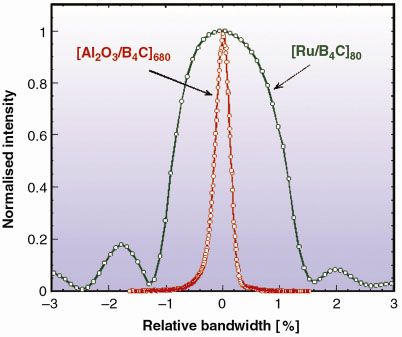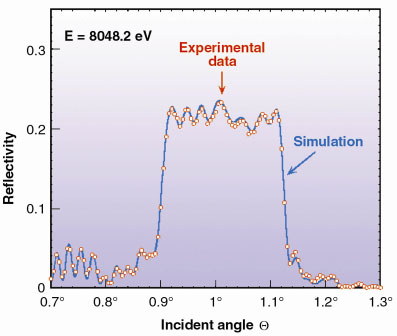- Home
- Users & Science
- Scientific Documentation
- ESRF Highlights
- ESRF Highlights 2001
- Methods and Instrumentation
- Tailored Multilayers: Narrow or Wide Bandpass
Tailored Multilayers: Narrow or Wide Bandpass
Typical multilayers used as optical elements at third-generation synchrotrons provide a spectral bandwidth of 1 to 5%. During the past year, the ESRF multilayer laboratory has developed new types of multilayer structures to extend the range of energy resolution to higher as well as to lower values.
To obtain narrow bandpass multilayers it is necessary to increase the number of layers contributing to a Bragg reflection. This can be achieved by using materials of low absorption and low optical contrast at the given photon energy. From the variety of available systems we have chosen Al2O3/B4C multilayers [1] that fulfil the above requirements for a wide energy range and that also allow smooth layer growth with low interface roughness. Al2O3/B4C samples containing up to 800 layer pairs were characterised on a high-resolution reflectometer installed on BM5, the Optics beamline. We obtained a spectral bandwidth of only 0.27 % (see Figure 169) with a reasonable peak reflectivity of about 35 %. However, residual errors in the stack affect the performance and a further work will be necessary to improve the sample quality. Here, extremely stable deposition parameters are mandatory.
 |
Fig. 169: Spectral bandwidth of a [Al2O3/B4C]680 multilayer measured at 12 keV as compared to that of a conventional [Ru/B4C]80 multilayer. |
A different approach has been applied to fabricate wide bandpass multilayers. In this case, depth-graded structures are required to fulfil the Bragg condition either for fixed energy and varying angles or vice versa. The key problem is to find the vertical layer composition profile that will produce a given reflectivity profile. We have based our study on theoretical work done by Kozhevnikov et. al. [2] who used a combination of an analytical approximation followed by a numerical fit calculation to obtain the required sequence of layers. As a first example, we have designed a multilayer providing a constant reflectivity of about 20% at 8048 eV within an angular range from about 0.9° to 1.1° resulting in a Ni/B4C sample consisting of 43 irregularly spaced bi-layers. Figure 170 shows the experimental data as well as a simulation that takes into account the remaining fabrication errors. As mentioned above, stable conditions during the coating process play a crucial role. Further development of wide bandpass multilayers will be one of the main activities in the multilayer laboratory during the next year.
 |
Fig. 170: Reflectivity of a [Ni/B4C]43 depth-graded multilayer optimised for incident angles between 0.9° and 1.1° at a photon energy of 8048 eV. The experimental data are practically indistinguishable from those of the simulation. |
References
[1] Ch. Morawe, J.-Ch. Peffen, E. Ziegler and A.K. Freund, SPIE Proceedings 4145, 61-71 (2000).
[2] I.V. Kozhevnikov, I.N. Bukreeva and E. Ziegler, Nuclear Instruments and Methods in Physics Research, A 460, 424-443, (2001).
Principal Publication and Authors
Ch. Morawe, J.-Ch. Peffen, E. Ziegler and A.K. Freund, SPIE Proceedings 4501, 127-134 (2001).
ESRF



